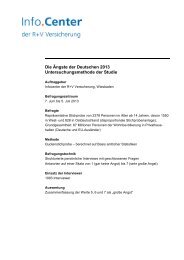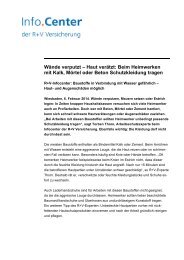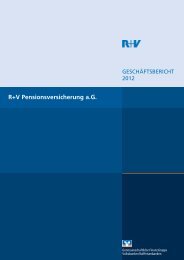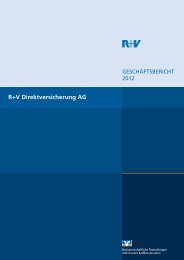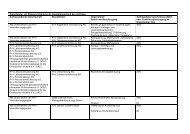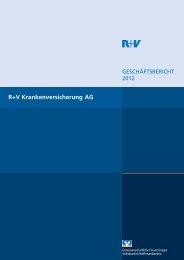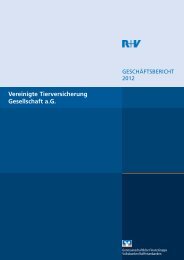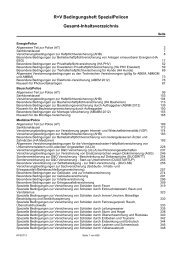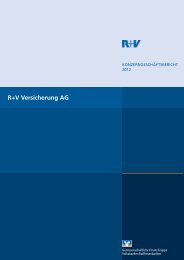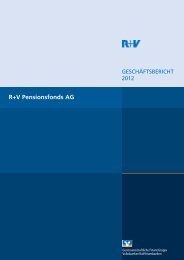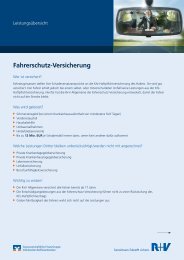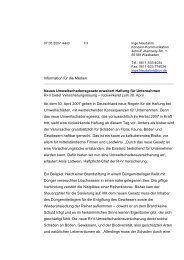R+V Versicherung AG Annual Report
R+V Versicherung AG Annual Report
R+V Versicherung AG Annual Report
Create successful ePaper yourself
Turn your PDF publications into a flip-book with our unique Google optimized e-Paper software.
Investment risks:<br />
In order to create „insurance coverage“<br />
products, insurance companies expose<br />
themselves to risks such as changes in<br />
market prices, credit ratings and liquidity<br />
as part of their investment activities. <strong>R+V</strong><br />
<strong>Versicherung</strong> <strong>AG</strong> counters these risks by<br />
observing the basic principle of achieving<br />
the greatest possible security and profitability<br />
while maintaining the liquidity of the<br />
insurance company at all times. In particular,<br />
investment policy aims to minimize risks<br />
by maintaining an appropriate mix and<br />
diversification of investments. Derivative<br />
financial instruments, structured products<br />
or asset backed securities are only used in<br />
accordance with supervisory law provisions<br />
set out in BAV (Federal Insurance Supervisory<br />
Office) circulars R 3/2000, R 3/99<br />
and R 1/2002. Their use is explicitly regulated<br />
by internal directives. Extensive, timely<br />
reporting ensures that the different risks are<br />
regularly monitored and presented transparently.<br />
Extrapolating the capital market situation<br />
at the end of 2002 to December 31,<br />
2003 and continuing the methods adopted<br />
in 2002 to calculate lasting impairments,<br />
the Company expects investment income<br />
to make a positive contribution to the net<br />
income for the year.<br />
At an organizational level, <strong>R+V</strong> <strong>Versicherung</strong><br />
<strong>AG</strong> counters investment risks by ensuring<br />
the strict functional separation of trading,<br />
settlement and financial control.<br />
Currency risks:<br />
As far as possible, liabilities in foreign currencies<br />
arising from reinsurance business<br />
are matched with investments in these foreign<br />
currencies. This allows exchange rate<br />
gains and losses to be largely offset by the<br />
correlative effect.<br />
27<br />
Operating risks:<br />
Operating risks are risks from general business<br />
activities. They arise as a result of<br />
human behavior, technical faults, weaknesses<br />
in process or project management<br />
or external influences.<br />
Risk provisioning using<br />
the internal control system:<br />
The main instrument used by the <strong>R+V</strong><br />
Group to limit operating risks is the internal<br />
control system. The Group protects against<br />
the risk of errors and fraudulent activities in<br />
its administration by providing regulations<br />
and controls in its specialist departments<br />
and by reviewing the application and effectiveness<br />
of the internal control systems in<br />
Group audits. As far as possible, payment<br />
flows and undertakings are handled by<br />
computer. Additional security is provided by<br />
predefined, electronically stored powers of<br />
attorney and authorization rules, as well as<br />
automatic random checks performed by the<br />
stored random generator when policies are<br />
drawn up. Manual processing is conducted<br />
according to the dual control principle.<br />
The internal monitoring of the regulations<br />
governing the risk management system,<br />
particularly with regard to their effectiveness,<br />
was reviewed by the Group audit<br />
department in 2001 for the first time. The<br />
implementation of the resulting measures<br />
was monitored by the Group audit unit and<br />
within the framework of the risk conference.



